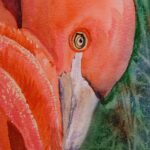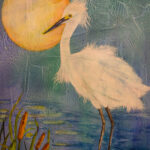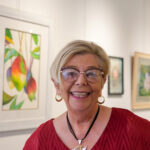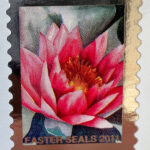
Although many artists dream of having a career in the arts from day one, the majority find they must put their talents aside for a time to make a living in some other fashion. Mary Ann Hall is one of those people.
Although the arts were not part of everyday family life, Hall recalls sitting on the back porch of her parents’ house as a 10-year-old, drawing from a kit that her mother had purchased for her.
“I never knew of artists; I was never exposed to the art world. Growing up in an industrial town, the arts weren’t available,” she explains.
When Hall began taking watercolor lessons in high school, she was in a class with 18-year-olds who had already been taught mechanical drawing, which hadn’t been available in her earlier schools.
“Mechanical drawing was for guys. Girls were supposed to take home [economics]. I was behind the curve on that. So I started to take a lot of watercolor lessons to try and catch up, because that was the medium for interior design, which is what I wanted to go into,” says Hall.
“I got a scholarship to a college, but my dad didn’t want to fill out the paperwork, because he believed that girls will get married, so why …”
Fortunately, Hall was able to talk him into letting her attend a two-year college and she went on from there. As her father wanted her to study computer science, something she could make a living out of, she received a degree in computer information science.
“My dad had four daughters and I think he wanted to make sure they didn’t come back, I guess. My education was a long, long struggle.”
Putting herself through school, Hall went on to earn a master’s degree and a Ph.D. in business, doing so willingly.
“You have to really want it to go that route,” says Hall.
After a divorce, Hall again delayed her artwork in order to earn a reliable, steady income to support herself and her daughter. She became a university professor at Ferris State University in Big Rapids, Michigan, and didn’t paint for 25 years.
“I told my kids to figure out what you want before you get married and have kids,” she says.
Remarried, Hall and her husband were offered buyouts, which they both took, and retired early. As they were both pilots, they were introduced to Vero Beach when they came to build a high-performance airplane at Velocity in Sebastian.
“Raytheon Missile Corporation bought one of our planes to test for radar,” she says.
They moved here permanently in 2004, which finally allowed her to do what she loved – painting. After meeting other Vero artists, she was asked to become one of the founding members of Gallery 14, now in its 14th year. Of the original eight, five remain, with three new additions. The co-owners feel that eight is a good working number.
“I jumped at it,” says Hall, who, with her business background, brought a solid gift to the table. “I didn’t realize at the time what an opportunity they were giving me. It’s such a wonderful, welcoming group here.”
Now, Hall says, painting has become all-consuming, in a good way.
“I can tell you what happens if I don’t paint. I actually feel like I am bubbling up inside; it’s a release. I see a lot of things, and people make suggestions of what to paint. Ideas are all over. I’m active and I see things, and I have lots and lots of ideas. Sometimes I actually make lists.”
Through art shows in Stuart, Brevard and Fort Pierce, Hall is constantly expanding her exposure to sell her work.
Organizers of the Brevard Aquarium Art Walk, to promote an aquarium they hope to build at Upper Canaveral, selected three of Hall’s paintings to be placed at public buildings throughout that county.
“I was with some heavy hitters up there, so I was pretty happy,” recalls Hall.
In 2011, she was greatly honored to be chosen as an Easter Seal stamp artist. The competition is stiff, as all 50 states participate. Barbara Landry, another Gallery 14 co-owner, has been a two-time winner.
“It is very rare to have two winners in the same gallery,” says Hall, explaining that thousands of entries are judged in Chicago, at the Easter Seals’ head office.
“I work mainly in watercolor, which I love. It’s my favorite; the transparency, the fluidness of it. It can just sparkle.”
For the past two years, Hall has begun to introduce a lot of texture to her work.
“I started with a piece of watercolor paper and went into the background and added pieces of gauze,” Hall explains.
After setting the paper for a while, until deciding what to do with it, she eventually determined that a bird would work, with a moon, and a reflection, so that’s what she painted.
Another break from tradition is painting watercolors on rice paper. Hall describes it as a batik process where you start with lighter colors and put wax on it to save it. The next layer has another value and more wax. Four to seven wax layers keep bringing up the darkness.
“Then you take that waxed paper, and you crinkle it all up to make all the cracks in the wax, and then add more watercolor. Then you iron it all up to see what you come up with. You can’t control it 100 percent,” she admits.
‘Sunny Days’ is a good example of this technique. ‘Moonlight Serenade’ is more traditional, working with the watercolor paper, to get the texture.
“More and more I am doing more contemporary paintings,” says Hall. Although the paintings tend to be simple in subject, she feels the technique makes them unique.
Hall says she is quite happy with her new, contemporary work, though she continues to paint traditional as well.
“I can see my evolution in style since I’ve been here; I know how the tools, how the paint, how everything works.
“I’ve learned and now I can explore. I’m always going to be learning, but I feel more comfortable [trying new things],” says Hall.
Her curious and adventuresome nature prompts her to continually try something new, such as using bright, bold colors.
“It is an amazing world. I am always looking and seeing; ideas are all over. My paintings are full of pure color and show the wonder of nature. I favor delicate watercolors for flowers, acrylics for abstracts and pastels for landscapes,” says Hall, who believes paintings should evoke an emotion from the viewer.
Photos provided









